Life Extension Magazine®
Falling is the leading cause of both fatal and non-fatal injuries in seniors, resulting in more than 2.8 million injuries, over 800,000 hospitalizations, and 27,000 deaths annually.*
The fear of falling only perpetuates the problem because it causes seniors to be less active. Unfortunately, this further reduces physical ability, which increases the risk of falling.
Carol Clements addresses this problem in her book, Better Balance for Life.
Drawing on more than 40 years of experience as a personal trainer, yoga instructor, and dance and movement specialist, Clements has developed an easy-to-follow program designed to help seniors build strength, flexibility, and ultimately, better balance.
This 10-week plan incorporates 40 balancing exercises into daily activities like brushing your teeth, getting dressed, and making coffee. Each exercise is explained in detail and includes helpful pictures to describe the movements. Clements also tells you what to do if you should find yourself falling.
In this interview with Life Extension®, Clements talks about many of the steps necessary for seniors to achieve better balance for life, while also giving a few specific examples from her book.
—Laurie Mathena
LE: Why do so many seniors struggle with balance issues?
Clements: The research shows that getting older is directly proportional to a loss of balance and the risk of falling. The potential reasons for problems with balance are many: medical conditions and side effects from prescription drugs, decreases in vision and reaction time, poor posture, muscle weakness in the hips and legs, gait pattern disorders, and the fear of falling itself. However, the main culprit for most of us can be summed up as: inactivity.
Activity is key. Activity will give you balance practice. Activity will give you strength. And that will give you confidence.
LE: What factors in the body contribute to our balance?
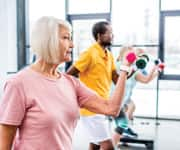
Clements: Helping us stand balanced are our brain, nervous system, vision, inner ear, muscles, bones, and other body-orienting reflexes. As we age, our vision can become less reliable, which may lead to falls, but let’s focus on the physical act of balancing.
No matter what your age, if you’re in a stable position, your body’s balance system turns off. When you’re sitting down, it’s turned off. While you stand, it’s switched on. As you age, you may spend more time sitting and less time standing.
Herein lies the crux of the matter: Balance is a skill. It gets better with practice and deteriorates without it. When you limit your activities, you practice balancing less and therefore diminish your balancing skills.
The solution is to stimulate your sense of balance while minimizing the risk of falling. You need to practice balancing.
LE: What are a few ways people can reduce their risk of falling?
Clements: You can’t change your age, but you can:
- Wear sensible and flexible-soled footwear,
- Be careful about rugs and clutter in your home,
- Light your living space better, and
- Improve your physical skills to counteract fear and avoidance behaviors in lifestyle activities.
LE: Speaking of improving your physical skills, in your book, you lay out a 10-week plan to help people achieve better balance. What does the program involve?
Clements: The 10 Weeks of Daily Activities are your foundation for a more active future. You can’t do much about your advancing age, but you can intervene to improve balance, mobility, strength, and the self-assurance that arises from an appreciation of your own abilities.
Each week you add four simple activities to your daily routines. The challenges gradually increase in difficulty, and as you progressively master each step in the program, you’ll begin to notice that you’ve become more confident.
The goal of the 10 weeks and its progression of activities is to practice balancing, build strength, and garner confidence to conquer the fear of falling.
LE: What role do your feet play in balance?
Clements: If your feet were as stiff as blocks of wood, they would not serve as a good base for balancing or an easy walking stride. Without flexible feet, you would have to depend more on your thighs and the front of your hips to walk.
Articulation, or joint mobility, of your foot gives you the power to push off from the front of your foot, or forefoot, and your big toe. This push propels your body forward so that walking is falling forward from one foot to the next.
Relaxed micro-movements of the foot are an important part of standing and balancing. If your feet lack mobility, other parts of your body may be working too hard to compensate for a too rigid base. It will be much harder to balance.
LE: What can individuals do to help release their feet?
Clements: Find a tennis ball, or even better, a solid rubber ball of about that size. Place it on the floor and stand where you can touch sturdy furniture or a wall for support. Position your right foot on top of the ball, with the ball under your forefoot. The joints at the base of your toes and part of your forefoot, the metatarsal bones, will take a dome shape from the ball underneath.
Gradually transfer your body weight over the ball, allowing the metatarsals to mold to the shape of the ball. It may not feel entirely pleasant at first, so take it easy and go slowly. For one minute, maintain a bearable amount of your body weight over your forefoot while it is cupped and pressing the ball.
Now, roll the ball directly under the center of your foot and its primary arch. Gradually put weight onto the ball, or as much weight as you can tolerate. For one minute, maintain a bearable amount of your body weight over your arch while it is mashing the ball.
After you have released the stiffness from the bottom of your right foot, take your foot off the ball and stand on the floor. Your toes may feel straighter and longer. Your foot will feel wide, long, and grounded, providing a better base. Give your left foot the same treatment.
LE: Initially, you focus on stretching and increasing your body’s range of motion. Can you give an example of an exercise from week one?
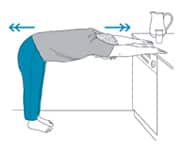
Clements: Whenever you wait for the water to boil, the toaster to toast, or the microwave to heat, take a moment to stretch the back of your body. Stand with the front of your body touching the kitchen counter. Put your hands on the kitchen counter and step away slowly as you lean forward until your back is flat and at a 90-degree angle to your legs (or as close as you can comfortably come to a right angle).
You will be in the shape of an L, legs perpendicular to the floor. Spread your fingers and reach your arms away from your hips while the tail end of your spine reaches in the opposite direction, away from your fingertips. Feel your back getting longer and imagine your breath flowing in between each bone of your spinal column.
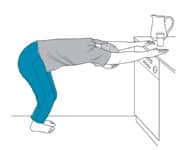
If you can’t get your back flat, or feel uncomfortable, then bend your knees. If your back feels long and flat, then try straightening your legs. You are stretching to feel the length of your entire back body, including the back of your legs.
To come out of the stretch without putting your back at risk for strain, keep your hands on the countertop and walk all the way in toward the counter before you roll your spine up to vertical position.
LE: How does the way you walk impact your balance?
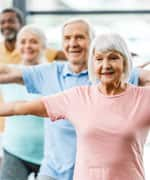
Clements: Since gait disorders are a predictor of falling, it’s well worth examining how you walk—and exploring how you can unify your body mechanics to walk more powerfully.
When you are walking, use the image of a helium balloon as the back of your head, behind your ears—not under your chin—so that the back of your neck lengthens and your head floats back and up instead of sinking forward. Imagine that your cheekbones are sliding backward, in the direction of behind your shoulders.
A lifestyle of driving, gazing at a screen, and rounding your shoulders may have deflated your head balloon and compressed the back of your neck. This forward head position inhibits the spinal movement needed for a healthy striding gait. Walk and signal the adjustment of your head and neck relationship with the cue “helium balloon.”
LE: What if some of the exercises are too difficult?
Clements: Don’t be discouraged if, with your first attempt, you don’t achieve the position shown in an illustration. In time you will acquire the flexibility or strength to perform the maneuver and benefit from the process of getting there. If the activities in a given week seem especially pertinent to your own physical issues, don’t hesitate to repeat that week—or select and repeat the activities that seem most helpful.
Most of all, you needn’t feel frustrated with what you may perceive as a failure to balance in the activity prescribed. With a secure fixture well within your reach, patiently steady yourself with the lightest motion you can to regain balance, then ease back into the balance challenge again.
Even if you lose your equilibrium, you succeed in turning on your balance system and achieve the goal of practicing balancing. In fact, while practicing, teetering out of the balance is a great rehearsal for a surprise loss of balance in the course of daily life. You are better able to cope because your body knows what to do from experience.
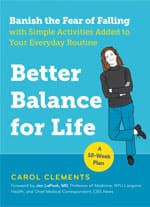
When you stand in an unstable position, sensory nerve endings that give information about your body’s position and movement are getting the stimulation and practice they need to stay functional. In a strange way, experiencing losing your balance is the goal.
LE: What’s the most important take-home message?
Clements: Don’t give up; keep moving. The temptation to give in to the sitting disease may be great. You may yearn to slow down. If you aren’t naturally inspired and motivated to keep physically active, then you may have to encourage yourself, force yourself, meet with a partner, do whatever it takes to make it easier or acceptable or mandatory—to move.
The more you move, the better your balance. The better your balance, the greater your confidence. Don’t give up hope. Keep trying.
Carol Clements holds a BS and MA in dance therapy, has more than 40 years of experience as a personal trainer, and currently works with older populations. She is an ambassador for the National Osteoporosis Foundation (NOF), the leading health organization dedicated to promoting strong bones for life.
If you have any questions on the scientific content of this article, please call a Life Extension® Wellness Specialist at 1-866-864-3027.
To order a copy of Better Balance for Life, call 1-800-544-4440.
Illustrations from Better Balance for Life by Carol Clements.
Illustrations © 2018 by The Experiment. Reprinted by permission of the publisher.
*Available at: https://www.ncoa.org/news/resources-for-reporters/get-the-facts/falls-prevention-facts/. Accessed June 4, 2019.

